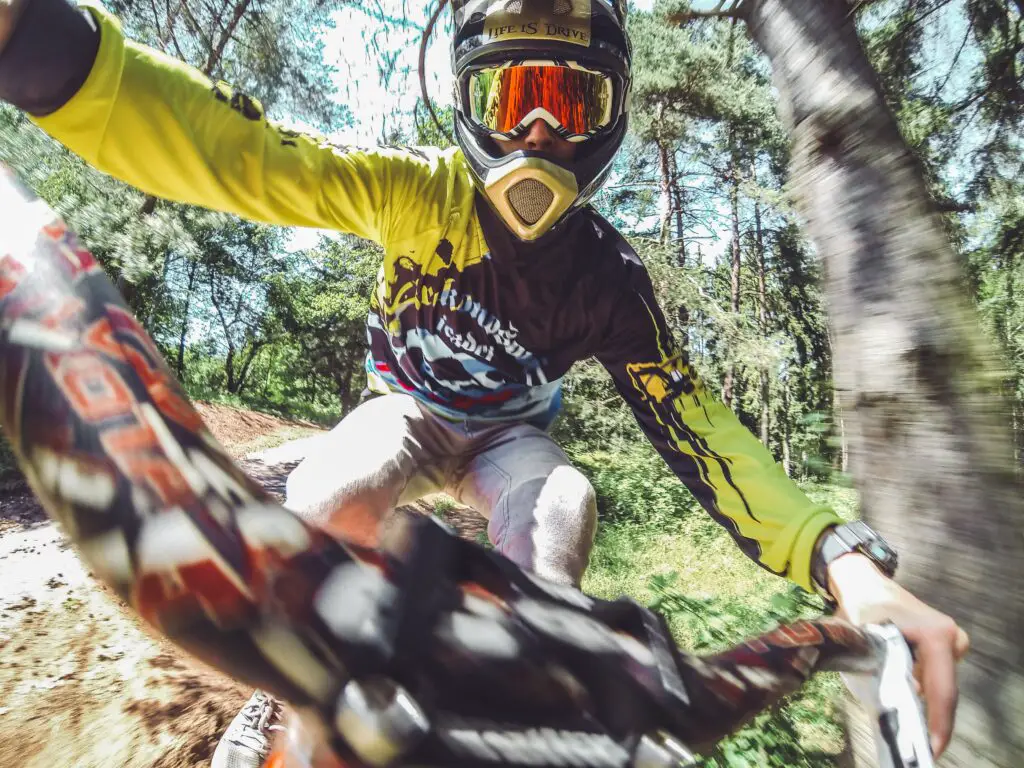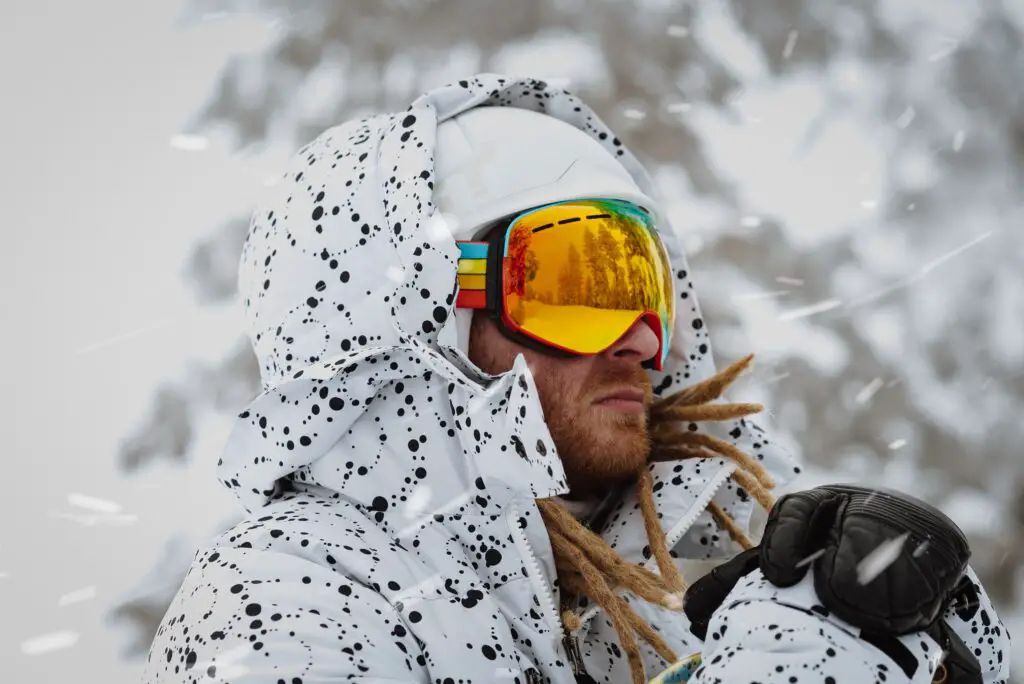Mountain biking is great fun but without the right kit, you can get injured. Fortunately, with decent eye protection, you can avoid injuries and enjoy the ride!
Keep reading for answers to the most commonly asked questions about MTB goggles.
What are MTB Goggles?
MTB goggles are a form of eye protection used by mountain bikers. They have a lens that protects the rider’s eyes from exposure to the Sun as well as flying debris. The lens sits in the lens housing and is secured to the rider’s face using a foam pad and an elastic strap.
Table of Contents

The lens is made from shatter-proof polymers to protect the eyes even during a crash. The lens housing has foam padding on the inside so the goggles fit comfortably on your face, and an elastic strap holds them securely in place even during those gnarly downhill rides.
Why do Mountain Bikers Wear Goggles?
A large number of mountain bikers wear goggles in order to protect their eyes from dust, mud, and other debris that is kicked up whilst riding. Goggles also offer protection from branches when riding in woodland areas, as well as protecting a rider’s eyes from the Sun.
Some mountain bikers prefer to wear a pair of riding glasses or regular sunglasses, however, these do not offer the same level of protection as goggles.
Goggles offer more protection than glasses as they are held in place with an elastic strap which, along with the foam padding around the edge of the goggles, forms a snug seal with the rider’s face.
Glasses on the other hand protect the eyes from debris aiming straight towards the eye, but the space around the lens on either side is unsealed, so there is the possibility of mud or dust finding its way behind the lens and into the rider’s eyes.
Do You NEED Goggles for Mountain Biking?
Goggles are not essential for mountain biking, however, a form of eye protection is strongly advised whether that is MTB goggles, glasses, or an appropriate substitute. Whilst glasses do protect the eyes to some extent, they do not match the level of protection provided by MTB goggles.
For beginner riders, a pair of sunglasses could provide sufficient protection from the elements and any mud that’s kicked up. That said, many sunglasses aren’t designed to withstand impact and could shatter in the event of a crash. This presents some very nasty potential hazards, so you should always ride with eyewear designed to take impact.
So in summary, even if you don’t want to purchase a pair of riding goggles straight away, you should at least wear a pair of glasses that can take an impact, ideally MTB-specific glasses.
Do Mountain Bike Goggles Fog Up?
A common issue many riders face when wearing goggles is that they fog up, or steam up.
Goggles will fog up when they get damp on the inside. This can be caused by allowing water to get into the goggles, however, it’s more likely due to the rider working up a sweat.
Once your face is sweaty, the sweat evaporating from your face beneath the goggles condenses on the inside of the lens, reducing your vision.
As sweat is the main culprit for a steamed up lens, many riders choose to remove their goggles when climbing (the portion of the ride where they’re most likely to work up a sweat) and only put them back on when they’re going downhill.
Some higher-end MTB goggles are ventilated with air intakes to prevent them from fogging up, however, these will typically be more expensive than standard goggles.
Are MTB Goggles Better than Glasses?
First off, it’s worth stating that eyewear designed specifically for mountain biking is always going to be better than a standard pair of sunglasses.
With that out of the way, now let’s consider what’s best between MTB goggles and MTB glasses by considering the pros and cons of each.
Pros and Cons of MTB Goggles
| PROS | CONS |
| – Offer maximum eye protection | – Can get very warm underneath and fog up |
| – Can be worn comfortably with full-face helmets | – Many models have a fixed lens or a lens that’s difficult to change |
| – Very wide field of view | – Bulkier than glasses, taking up more room in your bag |
Pros and Cons of MTB Glasses
| PROS | CONS |
| – More breathable than goggles so they’re less likely to fog-up | – Offer less protection than goggles, increased chance of eye injury |
| – Typically easy to change lenses | – Often less comfortable to wear with a full-face helmet |
Should You Wear MTB Goggles or Glasses?
MTB goggles and glasses have their own strengths and weaknesses. Which form of eye protection is most suitable comes down to the type of riding, the weather, helmet compatibility, and convenience. Let’s consider each factor in more detail:
Riding Style – For downhill riding or grueling enduro circuits, goggles are the best option. The overarching benefit of goggles is the unparalleled eye protection they offer, which you simply can’t get with glasses. When riding downhill at speed you want all the protection from mud, dust, and gravel you can get.
Weather – If it’s super hot outside a pair of goggles may just be too much trouble than they’re worth. They’ll have you overheating and unless you own a high-end pair, they’ll be fogging up non-stop. On the other hand, if it’s raining heavily or the trail is very muddy, goggles with their additional shielding are the way to go.
Helmet Compatibility – This one’s pretty simple. If you’re riding with a full-face helmet, goggles are probably going to be more comfortable. Whilst there are low-profile glasses that fit beneath a full-face helmet, a pair of goggles that strap over the helmet will feel better.
On top of that, if whatever you’re riding merits a full-face helmet, goggles are likely advisable anyway.
Convenience – If you ride a range of trails in all weather conditions and find that goggles are usually unnecessary for your needs, you’re probably better off with a pair of glasses. The ability to change lenses easily is very handy for riding in different light conditions, and you won’t have to deal with them fogging up.
Of course, these are only guidelines and there is some overlap between these criteria. For example, what if you’re riding downhill on a hot day? In this case you should use your knowledge of the trail and your common sense to determine the most appropriate eye protection.
What’s Cheaper: MTB Goggles or Glasses?
There are many options when it comes to purchasing MTB goggles or glasses, with both products being offered at a wide range of prices. That said, the cost of a low-end pair of MTB goggles will be similar to the same spec of MTB glasses. The same is true for mid and high-end products.
Whilst you don’t need to break the bank when purchasing either goggles or glasses, it is worth investing in a pair from a reputable brand, even if it’s one of their cheaper offerings.
Eyewear from reputable brands like Oakley, Scott, POC, and others will last longer and perform better than any super-cheap options from a generic online/dropshipping store.
Can You Wear Glasses Under MTB Goggles?
Glasses can be worn underneath MTB goggles, provided the goggles are designed to be compatible with glasses. The main feature to look out for when searching for goggles to wear over glasses is a small cut out in the side of the goggles that is designed to fit over the glasses’ arms.
A number of manufacturers offer over-the-glasses goggles. If you’re looking for somewhere to start, check out Oakley L-Frames, these are Oakley’s over-the-glasses goggles.
100% Sports Eyewear also offers glasses-compatible models.
What’s the Difference between Motocross and MTB Goggles?
Motocross(MX) goggles and MTB goggles are very similar as they serve similar purposes. The difference between them is that MX goggles are typically heavier. MX goggles also offer less ventilation than MTB goggles, as MX riders aren’t physically exerting themselves as much as MTB riders.
The debris kicked up by an MX bike is likely to be traveling faster and with more force than anything a pair of MTB goggles would typically have to deflect. Therefore, MX goggles are more heavy-duty than MTB goggles, which increases their weight.
Additionally, MX rides don’t work up a sweat quite like a mountain biker during a climb, so ventilation is less of a consideration with MX goggles.
Can Ski or Snowboarding Goggles be used for Mountain Biking?
Ski goggles can be used for mountain biking but they are not ideal. Ski lenses are tinted to provide optimal performance in snow which can be too dark for mountain biking and impede vision, particularly in shaded trail sections. Ski goggles are less ventilated as they are designed for cold weather use.

On top of that, skiers don’t wear full-face helmets, so ski goggles won’t be compatible with all MTB helmets.
In summary, if ski goggles are the only eye protection you have, they’re better than nothing. Just be aware that they will limit your ability to see on dull days or riding through thick woodland. If you can, invest in a pair of MTB goggles or glasses instead.
Can You Wear MTB Goggles with a Full-Face Helmet?
MTB goggles are commonly worn with full-face helmets. Full-face mountain bike helmets are designed to incorporate goggles. That said, every rider’s face is shaped differently so it’s important to find a helmet and a pair of goggles that feel comfortable and integrate well together.
Are Goggles Good for Mountain Biking?
Mountain bike goggles are excellent for mountain biking. They offer complete eye protection from the elements, debris kicked up whilst riding, and even during a crash. It is recommended that all mountain bikers wear some form of eye protection, with goggles being a great choice.
